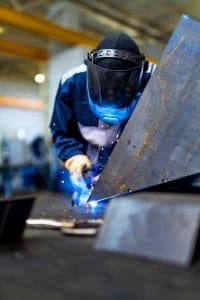Demystifying the Role of Shielding Gases in Welding
Welding is a vital process that involves joining two or more pieces of materials by melting them into a molten pool to form a bond. While welding is important, it can only be done with the right precautions. The employment of shielding gases is one such approach.
By going into great depth on shielding gases’ function, characteristics, and selection criteria, this blog post seeks to debunk the mystique surrounding their use in welding.
What are Shielding Gases?
During welding, shielding gases shield the welding region from air contaminants. Gases used as shields can be inert, reactive, or both. Argon gas and helium gas are prime examples of non-reactive gases that do not combine with other elements. Reactive gases, however, can combine with other elements, including oxygen and carbon dioxide.
Argon is the most used inert gas for welding, while carbon dioxide is the most used reactive gas. Other inert gases used in welding include helium and nitrogen. Shielding gas also serves the purpose of cooling the weld during the process, preventing overheating.
Why are Shielding Gases Important?
Shielding gases are crucial in welding because they protect the molten metal from atmospheric gases, preventing contamination and oxidation, which can affect welding characteristics such as arc stability, weld bead appearance, depth of penetration, and overall quality.
Shielding gases, such as inert gases like argon and helium, can also impact the heat generated by the arc and the resulting penetration depth, making proper selection crucial for success in welding, especially with reactive metals like aluminium that require special protective gases. Poorly formed, porous welds can result in costly rework without proper shielding.
Popular Shielding Gases and Their Properties
There are several different gases used as shielding gases. They are:
- Argon: Argon is an inert gas and one of the most widely used shielding gases. It provides excellent arc stability, good penetration, and a smooth weld bead appearance. Argon welding gas is also easy to use and suitable for various welding applications and materials.
- Helium: Like argon, helium is an inert gas that can be used alone or in combination with other gases such as argon. It has excellent heat transfer properties, high thermal conductivity, and can penetrate thicker materials. However, helium gas is expensive and not commonly used as a stand-alone gas.
- Carbon Dioxide: Carbon dioxide is a reactive gas that provides deep penetration and is suitable for welding thicker materials. It is also less expensive than other shielding gases. However, carbon dioxide can be challenging to use. Using CO2 for welding produces a spatter and can form a porous weld bead appearance. It is typically used with other gases, such as argon and helium, to make better-quality welds.
Selecting the Right Shielding Gas
Choosing the right shielding gas is crucial for producing high-quality welds. Several factors should be considered when selecting the best shield gas for a welding job, such as the material used, the welding technique, and the cost.
For example, aluminium and stainless-steel materials often require argon as the shielding gas, while carbon dioxide is better suited for welding mild steel. The welding technique used, such as TIG or MIG welding gas, will also play a role in choosing the right shielding gas. The cost of the shielding gas is also a consideration, as some gases, such as helium, can be expensive.
Our argon gas is ideal for welding and other applications that require an inert shielding gas. Our argon gas cylinders are available in a range of sizes, refill options, and prices to suit your needs, from
Whether you need bottled gases for a large-scale industrial application or a small welding project, we’ve got you covered.
Shielding Gas Techniques and Tips
Effective use of shielding gases is critical for achieving optimal welding results. Proper gas flow rates, nozzle selection, and safety considerations are crucial. Here are some essential tips on using shielding gas effectively:
- Maintain consistent gas flow rate: The flow rate should be constant throughout welding to ensure adequate protection and prevent contamination.
- Nozzle selection: The size should be selected according to the welded material and gas flow rate.
- Safety considerations: Proper ventilation and protective gear such as gloves, goggles, and respirators should be worn when welding. Ensuring the gas cylinder is correctly secured is also essential to prevent accidents.
Emerging Trends in Shielding Gases
The welding industry is continually changing, and shielding gases are no exception. One emerging trend in shielding gases uses mixed gases, such as a CO2 argon mix. These mixes balance cost and quality and are suitable for various materials.
Another trend is the development of new gas blends designed for specialised applications such as high-pressure welding and underwater welding. These unique blends offer improved weld quality and enable welding in challenging environments.
Shield Yourself With Bottle Gases
To ensure high-quality welds, selecting the right shielding gas is essential. At Bottle Gases, we offer a wide range of bottled gases for welding to cater to various requirements. Trust us for competitive pricing, exceptional customer service, and a broad selection of welding and gas products. Contact us today to order or learn more about our products and services. Let Bottle Gases help you take your welding to the next level!







